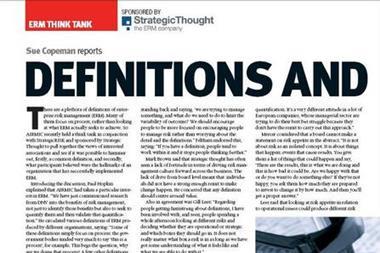Tom Wilson: I distinguish between allocation as an active process of giving limit space or capital to grow a business, and capital attribution which is a mechanism for understanding how the business uses resources. For a lot of the pricing exercises, especially at a granular level, attribution is a measurement issue, while allocation is a management issue. In my earlier comment, I was talking about the act of allocating capital and other forms of limits so that you steer the business which is a different issue to how you get an attribution mechanism.
Ferdia Byrne: But those who get the attribution mechanism right and can educate the business leaders about risk are going to be the ones that get the real competitive advantage in being able to pick their risks to find out what natural hedges they have in their portfolios. We’re already seeing a few examples such as purchasers of annuity liabilities finding that they can offer higher prices because there is a natural hedge between their mortality and longevity portfolios. From a pricing point of view, you need to know where your advantages are, where you have enough risk and whether you have the capacity to take on more to diversify. The winners will be those who really understand this and have done a good job at getting the risk right down to the required granular level to make strategic decisions. The other business success that probably needs to come with good capital attribution measurement and allocation is some credit from the regulators reflected in the amount of capital that has to held within the group. That is where some of the real value will come.
Tom Wilson: Most of us are constrained not by the regulators but by the rating agencies and the extent to which the rating agencies don’t recognise internal models and our dialogue with regards to capital adequacy. I am less worried about minimum regulatory requirements than I am about the conversations I need to have twice a year with the rating agencies.
John Redmond: There is an industry wide consensus that the rating agencies are emerging as additional regulators in a number of areas, particularly in relation to capital adequacy matters. In terms of measuring return on capital, in particular at the “granular level”, it is necessary to establish an efficient, yet robust, measurement model – it is apparent that not too many companies have established such models.
Tom Wilson: There has been a lot of talk about how a granular accurate model with regards to capital attribution and valuation is a critical element to getting a strategic advantage. I would agree that we should all strive on a continuous basis to get more granular, more accurate, etc. But there are two potential issues in the property and casualty and in the life arenas – on the P&C side managing through the cycle, and on the life side fair valuing the financial options and guarantees in life products – both of which may go against fundamental business principles and commercial objectives. You don’t need too fine a model to deal with these but a relatively blunt instrument coupled with a culture change.
Olly Reeves: Within Lloyd’s, we have a high number of syndicates, each of which has to do a capital allocation each year. As regards managing the cycle, risk based calculations can be volatile. At certain points in the cycle, on a risk basis you do not need as much capital, especially when you are purely relying on what the model is telling you. Then there are other times when the cycle is turning off when you suddenly need a lot more capital because of what the model is telling you. So the model tells you various detailed things where the calculation and allocation is done at a granular level. But when you take that figure up to the more strategic level of board discussion, you need to understand what it means, the drivers involved, and what strategic decisions and approaches are needed outside of what the model is telling you. Does the board fully understand all the detailed granular assessments it has been given? That is a massive question.
Oskar Buchauer: Risk managers generally are looking for ever deeper and more detailed modelling. But I have found in discussions with business unit managers when I’ve explained the capital attribution process and the capital allocated to their business unit, they challenge me because they don’t believe the attribution reflects their unit. Tom is right – capital allocation is a cultural issue.
Tom Wilson: In my experience, when senior management ask whether there are improvements to the model, most risk people will say yes. And then they may be told to come back next year when the model is better. The appropriate answer is that the model is good enough to use because it provides us with a better basis for undertaking decisions, it can always be better.
Oskar Buchauer: The model may be good enough for that purpose, but it will only ever give you 60% or 70% of your answer. The rest has to be business sense. Deciding your strategy, what you want to take on, etc, will never come out of a model.
Olly Reeves: You can’t model everything and we all know there are types of risk that are incredibly challenging to model. The cultural point about over-reliance on the answer coming out of the model is a key one. You are looking at data you have got and believe that the answer you have got must be right because it is the answer you have got, rather than considering the wider picture. Certainly in our capital setting at Lloyd’s, we have the most confidence in boards that come to us not just with a model but with various other information, for example on their strategic discussions or challenges back to the business, that sits around that model and maybe proves that the model’s answer is the right one.
Jonathan Titman: The model is just a tool in the whole ERM framework. It sits in the middle of the risk management framework and is used to drive processes around capital budgeting, pricing, reinsurance optimisation, etc. Too many companies regard the model as the be all and end all of the ERM capital management process. If you look at where companies plan to spend more time in the next year, a lot will say that they are planning to refine their model. In my view, they should be looking across the whole wider range of governance, setting their risk appetite, measuring performance on a risk adjusted basis, and running the business in a multi-faceted way rather than just concentrating on this particular tool.
Ole Hesselager: Capital allocation is a management tool. It is something we use for running the business in a more efficient and transparent way so it is important to attribute capital efficiently. Certainly, you should make sure that, if you have a certain line of business that year after year shows massive volatility compared to other lines, there should be an increased profit from that business over the long term. But there is a limit to the level of granularity that you can or should use in your attribution of capital. However, to put it into perspective, there are many risks associated with underwriting insurance. Getting the right volatility and risk for certain lines of business is difficult and important, as is getting the right level of risk. But if you look across the industry at the main areas where errors have been committed, what has gone wrong is not so much that someone has over a period of time allocated too little capital to support the volatility. Mis-pricing, not being aware of what kind of business you are actively underwriting, these are risk management failures that go beyond capital allocation, and we should view our occasional capital attribution problems from that perspective. On the other hand, we need to consider the economic capital aspects whenever there are important management decisions, in particular regarding areas of future growth and mergers and acquisitions. That is where you really should be very much aware of the capital or risk capital issues involved.















